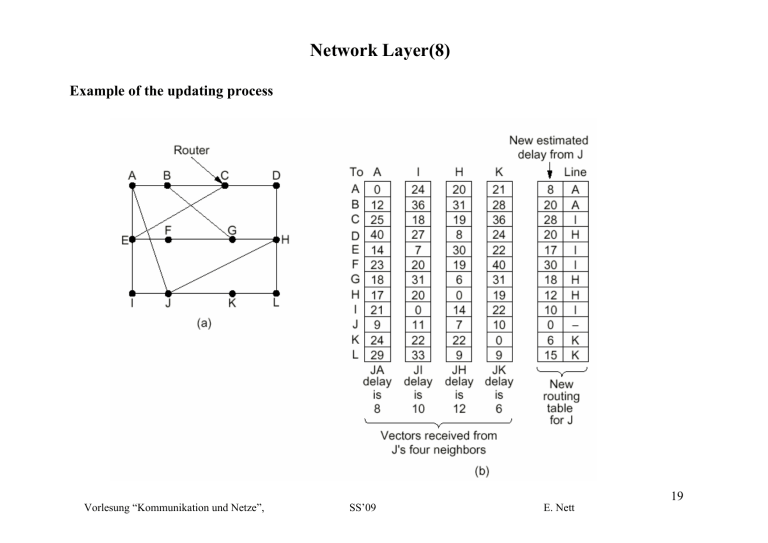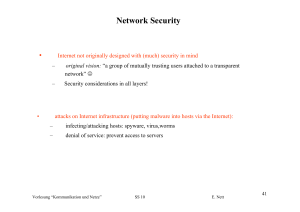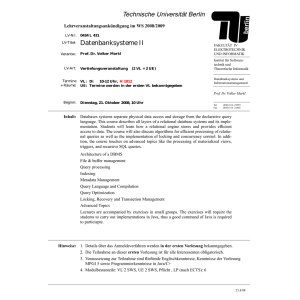Network Layer(8)
Werbung

Network Layer(8) Example of the updating process 19 Vorlesung “Kommunikation und Netze”, SS’09 E. Nett Network Layer(9) Example of the count-to-infinity problem Main problems: - The algorithm often takes too long to converge to infinity - How to define infinity? The Split Horizon Hack (Poisoned Reverse) Idea: The distance to A is reported as infinity on the line that packets for A are sent on 20 Vorlesung “Kommunikation und Netze”, SS’09 E. Nett Network Layer(10) Example where split horizon fails Link State Routing Idea: Each router must • discover its neighbors and learn their network addresses. • measure the delay or cost to each of its neighbors. • construct a packet telling all it has just learned. • send this packet to all other routers using flooding. • compute the shortest path to every other router using shortest path algorithm. 21 Vorlesung “Kommunikation und Netze”, SS’09 E. Nett Network Layer(11) Example of building Link State Packets The principle of Link State Routing is widely used in actual networks (e.g. IP). Hierarchical Routing Idea: Routers are divided into (sub)regions, thus making up a multilevel hierarchy. 22 Vorlesung “Kommunikation und Netze”, SS’09 E. Nett Network Layer(12) Example of routing in a two-level hierarchy with five regions 23 Vorlesung “Kommunikation und Netze”, SS’09 E. Nett Network Layer(16) Broadcast Routing Possible methods: • the source sends a distinct packet to each destination • flooding • reverse path ordering Example of reverse path ordering 24 Vorlesung “Kommunikation und Netze”, SS’09 E. Nett Network Layer(20) Differences than can occur in the network layer 25 Vorlesung “Kommunikation und Netze”, SS’09 E. Nett Network Layer(21) Summary: • it provides service to the transport layer • its main job is routing packets from the source to the destination – static routing algorithms include e.g. • shortest path routing • flooding – dynamic routing algorithms (used by most actual networks) include • distance vector routing • link state routing – other important routing topics are e.g. • hierarchical routing • broadcast routing 26 Vorlesung “Kommunikation und Netze”, SS’09 E. Nett Transport services and protocols • d en den al ic t or sp an tr • g lo • provide logical communication between app processes running on different hosts transport protocols run in end systems – send side: breaks app messages into segments, passes to network layer – rcv side: reassembles segments into messages, passes to app layer more than one transport protocol available to apps – Internet: TCP and UDP application transport network data link physical application transport network data link physical 27 Vorlesung “Kommunikation und Netze”, SS’09 E. Nett Transport vs. network layer • • Household analogy: network layer: logical communication between hosts transport layer: logical communication between processes – relies on, enhances, network layer services 12 persons sending letters to 12 persons • processes = persons • hosts = houses • transport protocol = Ann and Bill • network-layer protocol = postal service 28 Vorlesung “Kommunikation und Netze”, SS’09 E. Nett Transport Layer(3) Two principal alternatives: • protocol is connection-oriented (setup required) and reliable, like the telephone system (TCP) • protocol is connectionless (no setup required) and unreliable, like the postal system (UDP) Two basic philosophies for organizing the layer: • virtual circuits (identity of the connection) • datagram (identity of the independent packet) Comparison of datagram and virtual circuit protocols 30 Vorlesung “Kommunikation und Netze”, SS’09 E. Nett Transport Layer(5) Addressing (first approach) Addressing (second approach) 31 Vorlesung “Kommunikation und Netze”, SS’09 E. Nett Transport Layer(6) Establishing a Connection Problem: How to prevent that duplicates being delayed and, therefore, outdated packets lead to a wrongly established new connection Solution: Getting both sides (sender and receiver) to agree on a unique initial sequence number Implementation: The three-way handshake (also adopted in TCP) Normal operation 32 Vorlesung “Kommunikation und Netze”, SS’09 E. Nett Transport Layer(8) Duplicate CR (Connection request) Duplicate CR and ACK 33 Vorlesung “Kommunikation und Netze”, SS’09 E. Nett

